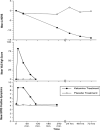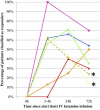Rapid-acting glutamatergic antidepressants: the path to ketamine and beyond
- PMID: 23726151
- PMCID: PMC3671489
- DOI: 10.1016/j.biopsych.2013.03.026
Rapid-acting glutamatergic antidepressants: the path to ketamine and beyond
Abstract
Traditional antidepressants require many weeks to reveal their therapeutic effects. However, the widely replicated observation that a single subanesthetic dose of the N-methyl-D-aspartate glutamate receptor antagonist ketamine produced meaningful clinical improvement within hours, suggested that rapid-acting antidepressants might be possible. The ketamine studies stimulated a new generation of basic antidepressant research that identified new neural signaling mechanisms in antidepressant response and provided a conceptual framework linking a group of novel antidepressant mechanisms. This article presents the path that led to the testing of ketamine, considers its promise as an antidepressant, and reviews novel treatment mechanisms that are emerging from this line of research.
Published by Elsevier Inc.
Figures





References
-
- Lopez-Munoz F, Alamo C. Monoaminergic neurotransmission: the history of the discovery of antidepressants from 1950s until today. Curr Pharm Des. 2009;15(14):1563–86. - PubMed
-
- Donoghue J. Selective serotonin reuptake inhibitor use in primary care: a 5-year naturalistic study. Clin Drug Investig. 1998;16(6):453–62. - PubMed
-
- Turner EH, Matthews AM, Linardatos E, Tell RA, Rosenthal R. Selective publication of antidepressant trials and its influence on apparent efficacy. N Engl J Med. 2008;358(3):252–60. - PubMed
-
- Organization WH. The global burden of diseasse: 2004 update. WHO Press; Geneva, Switzerland: 2008.
Publication types
MeSH terms
Substances
Grants and funding
LinkOut - more resources
Full Text Sources
Other Literature Sources
Medical

